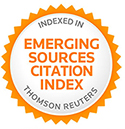Crítica de la noción de resiliencia en el campo de estudios de desastres
Resumen
Este artículo trata de introducir elementos críticos para valorar los conceptos más importantes en la prevención y recuperación de los desastres. Uno de ellos es el de resiliencia. Se hace una breve síntesis del concepto en su traslado al campo de estudios de desastres, de finales de los años setenta hasta su reactivación reciente, a propósito tanto de las complicaciones que ha representado el concepto de ‘vulnerabilidad social’, sobre todo después del Decenio Internacional para la Reducción de Desastres Naturales (DIRDN) de la ONU, como de las pautas de acción internacional para reducir efectos adversos del cambio climático.
Palabras clave
Texto completo:
PDFReferencias
AGUIRRE, B. 2006. On the concept of resilience.Disaster Research Center. University
of Delaware. Preliminary Paper No. 356.Newark, Delaware-USA.
ALEXANDER, S. 2008. The Resilience of Vulnerable Households: Adjusting to Neoliberal
Capitalism in the Aftermath of Hurricane Iris. En: Gunewardena, Nandini y Mark
Schuller, Eds. Capitalizing on Disasters. Neoliberal Strategies in Disaster Reconstruction.
-116. Lanham, N. York,Toronto. Altamira Press. Globalization and
the Environment Series.
ANTEZANA, M. E. 2010. Resiliencia. Disponible en:
http://www.newsmatic.e-pol.com.ar/index.php?pub_id=204&sid=1249&aid=61631&eid=60&NombreSeccion=Articulo
s&Accion=VerArticulo&PHPSESSID=9c302edea5c66bde8a949b2228df5845 [Consulta:marzo, 2013].
AUF DER HEIDE, E. 2004. Common Misconception about Disasters: Panic, the “Disaster
Syndrome” and Looting. En: O’Leary, M. (Ed.). The First 72 Hours: A Community
Approach to Disaster Preparedness.340-380. Universe Publishing. Lincoln,Nebraska.
BARRANCO, C. 2009. Trabajo social, calidad de vida y estrategias resilientes. Revista
Portularia, 9 (2): 133-145.
BARTON, A. 1969. Communities in disaster:A sociological analysis of collective
stress situations. Doubleday and Company, Inc. Garden City, New York-USA. 162 p.
BIRKMANN, J. 2005. Danger need not spell disaster. But how vulnerable are we? En:
Research Brief. United Nations University/Institute for Environment and Human
Security. No I.
BLAIKIE, P.; CANNON, T.; DAVIS, I. & B. WISNER. 1994. At Risk-Vulnerability and
Disasters. Routledge. Londres & New York. 284 p.
BUCKLE, P. 1999. Re-defining community and vulnerability in the context of Emergency
Management. En: Australian Journal of Emergency Management. 13 (4): 21-26.
BUCKLE, P. & M. G, SMALE S. 2000. New approaches to assessing vulnerability and
resilience. Australian Journal of Emergency Management. 15 (2): 8-14.
BURTON, I.; KATES, R, & G. WHITE. 1993. The Environment as Hazard. Guilford
Press. New York/London. 290 p.
CADAVID, S. 2010. Resiliencia comunitaria.La resiliencia. Blogspot. Disponible en:
http://intervenciondelacomunidad-sandra.blogspot.mx/2010/11/resiliencia-comunitaria.
html. [Consulta: julio, 2014].
CANNON, T. 2000. Vulnerability Analysis and Disasters. En: D. J. Parker (ed.) Floods.
-30. Routledge. New York-USA. Disponible en:
www.radixonline.org [Consulta:agosto, 2014].
CHEVÉRIAT, C. 2000. Natural disasters in Latin America and the Caribbean: An
overview of risk. Inter-American Development Bank. Washington. 104 p.
DOUGLAS, M. & A. WILDAVSKY. 1983. Risk and culture. An essay on the selection
of technological and environmental dangers. California University Press. Berkeley-
Los Angeles-London. 221 p.
DYNES, R. 1994. Community Emergency Planning:False Assumptions and Inappropriate
Analogies. International Journal of Mass Emergencies and Disasters. 12(2): 141-158
EIRD. 2012. Cómo desarrollar ciudades más resilientes. Un manual para líderes
de los gobiernos locales. Una contribución a la campaña mundial 2010-2015. Estrategia Internacional para
la Reducción de Desastres de la ONU. Ginebra- Suiza. 103 p.
FORDHAM, M. & A. M. KETTERIDGE. 1998. ‘Men must work and women must weep’:
Examining gender stereotypes in disasters. En: Elaine Enarson and Betty Hearn Morrow
(eds.) The gendered terrain of disasters through women’s eyes. 81-94.
Wesport. Praeger. London-UK.
FREEMAN, P. K.; MARTIN, L. A.; LINNEROOTH- BAYER, J.; MECHLER, R.;
PFLUG, G. & K. WARNER. 2003. Disaster risk management: national systems
for the comprehensive management of disaster risk and financial strategies
for natural disaster reconstruction.Inter-American Development Bank
(Banco Interamericano de Desarrollo).Washington-USA. 97 p.
FRITZ, C. & J. MATHEWSON. 1957. Convergence behavior in disaster. A problem
in social control. Nacional Academy of Sciences/Nacional Research Council. Publication
Washington-USA. 144 p.
GAILLARD, J. CH. 2007. Resilience of traditional societies in facing natural hazards.
En: Disaster prevention and management, 16 (4): 522-544.
HANDMER, J. 2008. Policy development and design for fire and emergency management.
En: The Australian Journal of Emergency Management. 23 (1): 21-29.
HEWITT, K. (Editor). 1983a. Interpretations of calamity. Londres. Allen and Unwin.304 p.
HEWITT, K. 1983b. The Idea of calamity in a technocratic age. En: Kenett Hewitt (Editor).
Interpretations of calamity. 3-32. Allen and Unwin. London-UK.
KLEIN, R. J.; NICHOLLS, R. J. & F. THOMALLA. 2003. Resilience to Natural Hazards:
How Useful Is This Concept? Environmental Hazards. (5):35-45.
KLEIN, N. 2007. La doctrina del shock. El auge del capitalismo del desastre. Paidos.
México.
LAVELL, A. 1999. Un encuentro con la verdad: los desastres en América Latina durante
Anuario Político y Social de América Latina. FLACSO. San José-Costa
Rica. N° 2. 33 p.
LAVELL, A. 2003. La gestión local del riesgo. Nociones y precisiones en torno al
concepto y la práctica. CEPREDENAC/ PNUD. San José-Costa Rica. 101 p.
LAVELL, A. 2005. Los conceptos, estudios y práctica en torno al tema de los riesgos y
desastres en América Latina: evolución y cambio. 1980-2004: el rol de La Red, sus
miembros y sus instituciones de apoyo. Documento electrónico. La Red de Estudios
Sociales para la Prevención de Desastres.Disponible en: www.desenredando.org.
[Consulta: junio de 2007].
MACÍAS, J. M. 1992. El significado de la vulnerabilidad social frente a los desastres. Revista
Mexicana de Sociología. (4): 3-10.
MACÍAS, J. M. 2010. La configuración teórica del proceso riesgo-desastre. CIESAS.
México. 187 p.
MACÍAS, J. M. 2012. Estado y desastres. Deterioro,retos y tendencias en la reducción
de desastres en México 2011 En: José Luís Calva (Coordinador). Cambio climático
y políticas de desarrollo sustentable.368-394. Juan Pablo Editor/Consejo Nacional
de Universitarios. México.
MACÍAS, J. M. y B. E. AGUIRRE. 2006. A critical evaluation of the United Nations Volcanic
Emergency Management System: Evidence from Latin America. Journal of
International Affairs. 58 (2): 43-61.
MANCIAUX, M. (Comp). 2001. La resiliencia: resistir y rehacerse. Barcelona. Editorial
Gedisa S. A. Barcelona-España. 318p.
MATURANA, A. 2011. Resiliencia comunitaria frente a emergencias y desastres. En: La
Cultura Preventiva como factor de Resiliencia frente a los Desastres. Conferencia virtual
Iberoamericana. Dirección General de Protección Civil y Emergencias-Ministerio
del Interior. (Febrero-Abril, 2011). España.
MAYUNGA, J. S. 2007. Understanding and Applying the Concept of Community Disaster
Resilience: A Capital-based Approach. A draft working paper prepared for the
Summer Academy for Social Vulnerability and Resilience Building, 22-28 July 2007,
Munich-Germany. 16 p. Disponible en:
https://www.ehs.unu.edu/file/get/3761.
MELILLO, A. 2005. Sobre Resiliencia. El pensamiento de Boris Cyrulnik. En: Perspectivas
Sistémicas, marzo- abril. No. 85.Disponible en:
http://www.redsistemica.com.ar/melillo.htm [Consulta: 15 de marzo de 2013].
MILETI, D.; DRABEK, T. & E. HAAS. 1975. Human systems in extreme environments.
Institute of Behavioral Sciences.University of Colorado. Boulder, Colorado-
USA. 230 p.
MUNIST, M.; SANTOS, H.; KOTLIARENCO, M.A.; SUÁREZ OJEDA, E. N.; INFANTE, F. y
E. GROTBERG. 1998. Manual de identificación y promoción de la resiliencia en
niños y adolescentes. Washington. OPSOMS, Fundación Kellogg, Autoridad Sueca
para el Desarrollo Internacional. 88 p.
OLIVER-SMITH, A. 1986. Introduction: Disaster context and causation. An overview of
changing perspectives in disaster research. Studies in Third World Societies.
(36):1-34.
PATON, D. & D. JOHNSTON. 2006. Disaster resilience. Charles C. Thomas Publisher
LTD. Sprinfield. 326 p.
QUARANTELLI, E. L. 1994. Disaster studies: the consequences of the historical use of sociological
approach in the development of research. International Journal of Mass
Emergencies and Disasters. (12): 25-49.
QUARANTELLI, E. L. 1998. What is a Disaster? Perspectives on the Question.
Routledge. London. 311 p.
SCHULLER, M. 2008. Deconstructing the Disaster after the Disaster. En: Gunewardena,
Nandini y Mark Schuller (Eds.). Capitalizing on disasters. Neoliberal strategies
in disaster reconstruction. 17-28. Lanham, N. York, Toronto. Altamira Press.
Globalization and the Environment Series.
SCOTT, J. C. 2000. Los dominados y el arte de la resistencia. Ediciones Era. México.
p.
SUÁREZ, O. N. 2001. Una concepción latinoamericana:la resiliencia comunitaria. En:
Aldo Melillo y N. Suárez Ojeda. Resiliencia: descubriendo las propias fortalezas.
-82. Paidós. Barcelona-España.
SECRETARÍA DE SEGURIDAD PÚBLICA, 2011. Resiliencia en comunidades violentas.
Secretaría de Seguridad Pública. México. 35 p.
SUSMAN, P.; O’KEEFE, P. & B. WISNER. 1983.Global disasters, a radical interpretation.
En: Kenett Hewitt (Editor). Interpretations of calamity. 263-283. Allen and Unwin.
London-UK.
TIERNEY, K. 2006. The importance of social resilience. In: SPPD Community
Connection. The USC School of Policy, Planning, and Development, University of
Southern California. (3):1. Disponible en:
http://www.usc.edu/. [Consulta: febrero,2013].
TOBIN, G. & L. WHITEFORD. 2001. The role of women in post-disaster environments:
Health and community sustainability. Final Technical Report for the Center for Disaster
Management and Humanitarian Assistance. Noviembre. 388 p.
TOMKIEWICZ, S. 2001. El buen uso de la resiliencia: cuando la resiliencia sustituye a la
fatalidad. En: Michel Manciaux (Compilador) La resiliencia: resitir y rehacerse.
-300. Editorial Gedisa S. A. Barcelona-España.
TORRY, W. 1979. Intelligence, Resilience and Change in Complex Social Systems: Famine
Administration in India. Rev. Mass Emergencies. (2): 71-85.
TWIGG, J. 2007. Características de una comunidad resiliente ante los desastres: Nota
guía. Disaster Risk Reduction Interagency Coordination Group, del Departamento
para el Desarrollo Internacional del Gobierno del Reino Unido. 42 p. Disponible en:
http://www.benfieldhrc.org/disaster_studies/projects/communitydrrindicators/
community_drr_indicators_index.htm
WATTS, M. 1983. On the poverty of Theory: natural hazard research in context. En: Kenett
Hewitt (Editor). Interpretations of calamity.231-262. Allen and Unwin. London-UK.
WALLACE, A. 1956. Tornado in Worcester.National Academy of Sciences/National
Research Council. Disaster Study No. 3. Washington-USA. 165 p.
WERNER, E. & R. SMITH. 1982. Vulnerable but invincible: a longitudinal study of
resilient children and Youth. McGraw- Hill. New York-USA. 229 p.
WINCHESTER, P. 1992. Power, Choice and Vulnerability. A Case Study in Disaster
Mismanagement in South India.1977-1988. James & James. London. 253p.
Enlaces refback
- No hay ningún enlace refback.
DOI: https://doi.org/10.53766/RGV
La Revista Geográfica Venezolana se encuentra actualmente indizada en:
 |  |  | |
 |  |  |  |
 |  |  |  |
![]()
Todos los documentos publicados en esta revista se distribuyen bajo una
Licencia Creative Commons Atribución -No Comercial- Compartir Igual 4.0 Internacional.
Por lo que el envío, procesamiento y publicación de artículos en la revista es totalmente gratuito.
